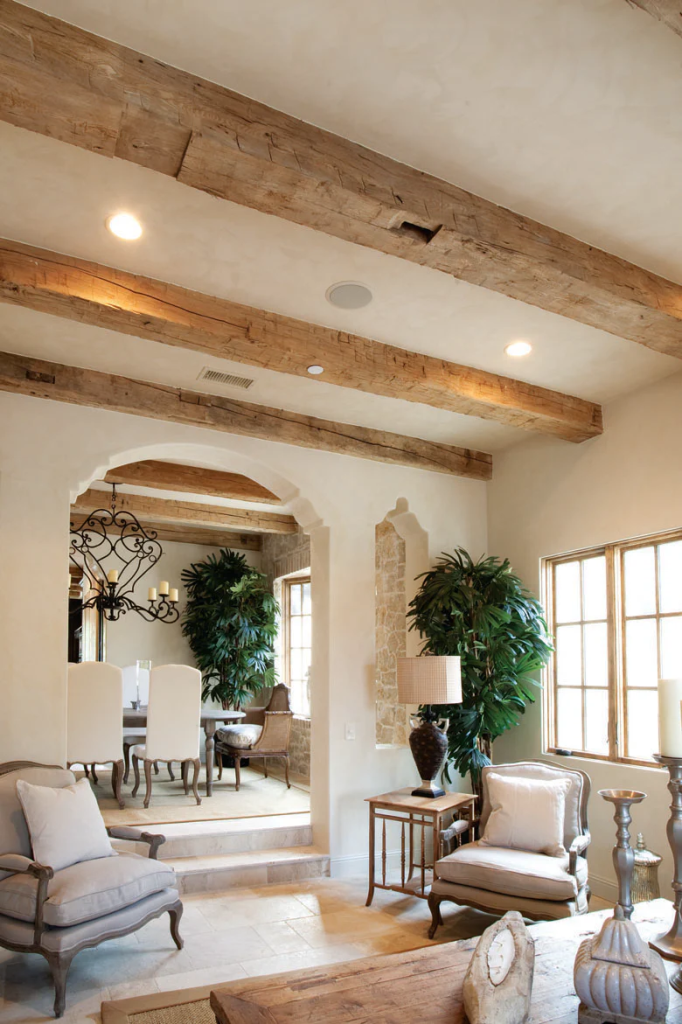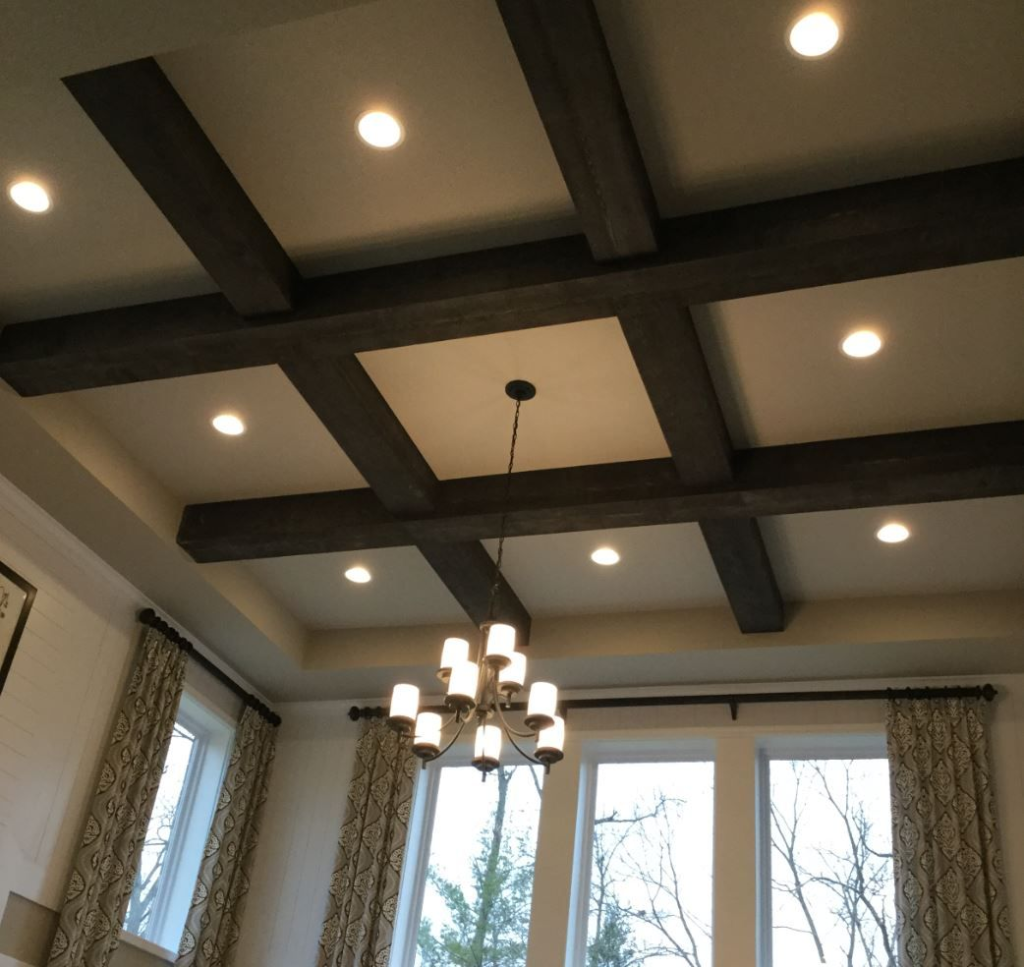When designing a home or updating its interior, one of the most impactful choices you can make is the inclusion of real wood ceiling beams. These beams add character, warmth, and a timeless quality to any room, transforming ordinary spaces into inviting, stylish areas. Whether you’re aiming for a rustic farmhouse aesthetic or a more contemporary touch, real wood ceiling beams provide unmatched beauty and charm that will last for generations.

In this article, we’ll explore everything you need to know about real wood ceiling beams, from their benefits to installation, design ideas, and maintenance tips. We’ll also delve into how they can enhance your home’s value and aesthetic appeal.
Read too: Kitchen Lighting For A Vaulted Ceiling: Illuminating Your Space with Style and Functionality
What Are Real Wood Ceiling Beams?
Real wood ceiling beams are structural or decorative beams made from solid, natural wood. They are typically installed on the ceiling to add architectural interest and enhance the overall look of a room. These beams can be part of the ceiling’s structural framework or purely decorative, creating a striking visual element in both traditional and modern designs.
Real wood beams are crafted from a variety of wood species, including oak, pine, maple, cedar, and reclaimed wood, offering a range of finishes from light and rustic to dark and polished. The rich, natural textures and tones of real wood ceiling beams create an organic warmth that’s hard to replicate with synthetic materials.
Benefits of Real Wood Ceiling Beams
There are numerous benefits to incorporating real wood ceiling beams into your home design. Here are some of the key reasons homeowners choose real wood beams for their spaces:
1. Aesthetic Appeal and Visual Impact
The inclusion of real wood ceiling beams adds a touch of timeless beauty to any room. The natural grain patterns, textures, and colors of the wood can either complement or contrast with other design elements. These beams can create a rustic charm, a modern farmhouse feel, or even a more industrial vibe, depending on your style.
2. Increase Property Value
Adding real wood ceiling beams to your home can increase its overall value. The natural look of wood adds an upscale appeal that prospective buyers find attractive. It’s an investment that not only improves the aesthetics of your space but also enhances the resale value of your property.
3. Durability and Longevity
Unlike synthetic materials, real wood ceiling beams are built to last. When properly maintained, solid wood beams can remain functional and beautiful for generations. Whether used for structural or decorative purposes, these beams are known for their strength and ability to endure over time.
4. Energy Efficiency
Real wood ceiling beams can help with insulation. Wood is a natural insulator, meaning that it helps to regulate temperature by keeping rooms cooler in the summer and warmer in the winter. The beams themselves may not be the sole insulators, but they can contribute to a more energy-efficient home overall.
5. Versatility in Design
Real wood beams are incredibly versatile. They can be installed in almost any room of the house, including living rooms, kitchens, bedrooms, and even bathrooms. Whether you want to create a dramatic focal point or a subtle accent, real wood ceiling beams can be designed to suit any style or theme.
Choosing the Right Wood for Ceiling Beams
One of the most important decisions when installing real wood ceiling beams is selecting the right type of wood. Different wood species offer various benefits in terms of strength, appearance, and cost. Here are a few common types of wood used for ceiling beams:
1. Oak
Oak is a popular choice for real wood ceiling beams due to its durability and distinctive grain pattern. It has a strong, hard texture and takes stain well, which means it can be finished in a variety of ways to suit different design styles.
2. Pine
Pine is often chosen for its light color and relatively lower cost. It’s softer than oak, but still durable enough for most applications. Pine beams are ideal for creating a more relaxed, rustic aesthetic and can be left in their natural state or stained for a deeper tone.
3. Maple
Maple wood has a fine, consistent grain that lends itself to a more refined, polished look. It’s ideal for contemporary or more upscale designs. Maple beams are also very strong and durable.
4. Reclaimed Wood
For those looking to add a unique touch, reclaimed wood is an excellent choice for real wood ceiling beams. Reclaimed beams bring an eco-friendly element to your design, as they are salvaged from old buildings or structures. This wood often has a worn, aged look that adds character and history to a room.
5. Cedar
Cedar is another option for wood beams, particularly if you desire a light, aromatic wood. It is naturally resistant to decay and insects, making it suitable for humid environments. Cedar beams are particularly fitting for rustic or cabin-style interiors.
Design Ideas for Real Wood Ceiling Beams
The possibilities for incorporating real wood ceiling beams into your home are endless. Below are a few design ideas to inspire you:
1. Rustic Farmhouse Look
If you’re looking to achieve a warm, cozy, rustic feel, real wood ceiling beams are a perfect choice. You can use large, exposed beams in a farmhouse-style kitchen or living room to evoke a sense of country charm. Pair the beams with natural wood furniture, exposed brick, and soft, neutral colors to complete the look.
2. Modern Industrial Style
For a more industrial design, consider combining real wood ceiling beams with raw metal elements. A space with exposed ductwork, concrete floors, and steel fixtures can be softened by the natural warmth of the wood. Opt for darker stains or even reclaimed wood beams to enhance the edgy, industrial aesthetic.
3. Coastal or Beachy Vibe
In coastal homes, real wood ceiling beams painted in light tones like white or soft gray can complement the airy, fresh feeling of a beach house. Pair the beams with large windows that let in natural light and minimalist furniture to create a breezy, open atmosphere.
4. Traditional Elegance
For a more classic, formal look, real wood ceiling beams can be incorporated into dining rooms or entryways with intricate crown molding and detailed woodwork. In this setting, the beams serve as both a structural element and a key design feature, enhancing the space’s elegance.
Installation of Real Wood Ceiling Beams
Installing real wood ceiling beams is not a simple DIY project, especially if you’re using heavy, solid wood beams. While it’s possible to install them yourself if you have the right tools and expertise, it’s often best to hire professionals to ensure proper installation. Here are a few general steps involved in installing these beams:
1. Measure and Plan
Before beginning installation, carefully measure your ceiling space and plan the beam placement. Depending on the size of the room, you may want to install one or multiple beams. Ensure they are properly aligned and spaced for visual balance.
2. Install Mounting Brackets
For decorative beams, a mounting bracket system is often used. These brackets are attached to the ceiling structure and are designed to support the weight of the beams. If you are using structural beams, the installation will be more complex and require proper support.
3. Attach the Beams
Once the brackets are in place, carefully lift the beams into position and secure them to the brackets or ceiling structure. Beams can either be attached directly to the ceiling or installed as part of a dropped ceiling design, depending on the look you’re going for.
4. Finishing Touches
Once the beams are installed, you may want to apply a finish to enhance their appearance. Staining or painting your real wood ceiling beams can protect the wood and bring out its natural beauty. Additionally, it’s important to check the beams regularly for signs of wear and tear.
Maintenance of Real Wood Ceiling Beams
To keep real wood ceiling beams looking their best, regular maintenance is essential. Follow these steps to keep your beams in top condition:
1. Dust Regularly
Dust and dirt can build up on the surface of the beams, so it’s important to clean them regularly using a soft cloth or duster. Avoid using harsh chemicals that can damage the wood.
2. Apply a Protective Finish
Depending on the wood species and your personal preference, you may want to apply a protective finish to your beams every few years. A clear polyurethane or wax finish can help preserve the wood’s natural beauty and protect it from moisture and damage.
3. Inspect for Damage
Periodically check the beams for any signs of damage, such as cracks or signs of insect infestation. If necessary, treat the wood to prevent further damage.
Conclusion
Real wood ceiling beams are an investment that can bring warmth, character, and elegance to any space. Whether you’re enhancing the design of a modern home, creating a cozy farmhouse feel, or incorporating rustic charm, wood beams offer a timeless appeal. With the right choice of wood, careful installation, and regular maintenance, these beams can add beauty and functionality to your home for years to come.
